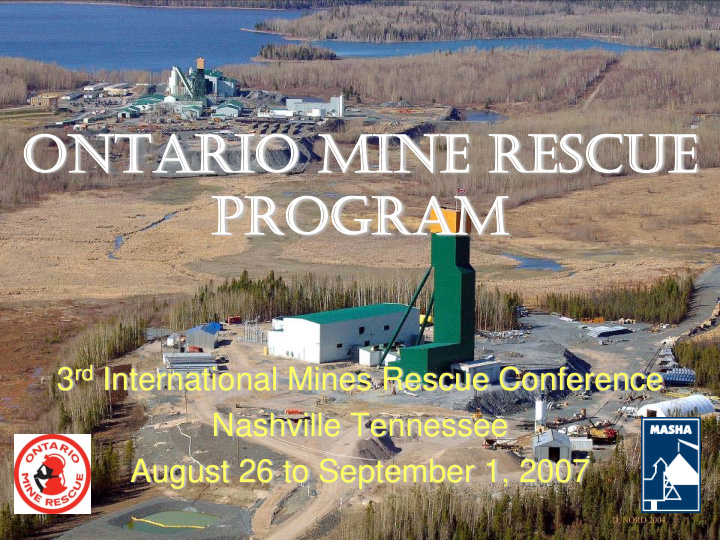



ONTARIO MINE RESCUE ONTARIO MINE RESCUE PROGRAM PROGRAM 3 rd International Mines Rescue Conference Nashville Tennessee August 26 to September 1, 2007 1
“EMERGENCY PREPAREDNESS IN THE 21 ST CENTURY” 2 2
“PREVENTABLE INCIDENTS!” 3
“ANCIENT CHINESE PROVERB” “If you plan for a year, plant rice.” “If you plan for 10 years, plant trees.” “If you plan for 100 years, educate mankind.” 4
“OUR HEALTH AND SAFETY MISSION IN ONTARIO IS TO …” … achieve a state of zero harm 5
“MINE RESCUE IS AN IMPORTANT PART OF OUR HEALTH AND SAFETY INFRASTRUCTURE” 6 6
7 “EMERGENCY RESPONSE” Safety System
“MINE RESCUE” Every jurisdiction has legislated requirements Vary according to types of mining Based on best practices that have evolved over time 8
“MINING FATALITIES IN ONTARIO” Hollinger Fire: 1928 39 fatalities Paymaster 1945: Rope breaks: 16 fatalities 1971: Amendment 1981: The Burkett to Mining Act Commission 1950 2000 1900 9
Fewer incidents results in increased need for 10 10 emergency response capability
“ONTARIO’S MINE RESCUE MODEL” Equipment Procedures Response Capability 11 Training
• Strategically located “Volunteers” • Standardized equipment, procedures, and training • Strategically located stations and substations • Mutual aid and cross mine training “ONTARIO MINE RESCUE’S • Continuous improvement process – assessment, APPROACH” adjustment, reintroduction, and feedback 12 12
13 “CONTINUOUS IMPROVEMENT Assess Reintroduce PROCESS” Introduce Adjust Feedback
“STANDARDIZED EQUIPMENT” • Mobility across mines and across entire province • Maintenance savings • Reduced “room for error” 14
“STANDARDIZED PROCEDURES” • Developed from incident review (both internal and external) • Practiced during training, competitions, and simulations • Continually reviewed and updated as necessary 15
• Standardized and performance based “TRAINING” • Leader’s guides, participant manuals, and performance check lists • Developed in consultation with manufacturers • Follow manufacturers recommended procedures • Developed inter-active CD’s and internet training 16
“EMERGENCY PREPAREDNESS TRIANGLE Command Centre Problem Solving Mutual Aid Briefing Officers Communication Technical Support Technical Support Standardization Technical First Competency Responders Systems Audit 17 17
“TRAINING RECORDS” • Electronic data base • Data shared with employers for record keeping • Information captured – Personal information – Levels of training – Oxygen time – Special certification (first aid, relief man) – Competency demonstration 18
“RESPONSE CAPABILITY” • Ensure adequate resources to handle any foreseeable emergency • Appropriate number of trained men • “Point in Time” Evaluation tool used to assess response capability 19
“EVALUATION” • Regular review and update of emergency plans • Test the emergency warning system • Audit to ensure employers meet or exceed legislated requirements • Conduct mine-wide emergency simulations • All incidents where teams are deployed are reviewed and action taken where necessary 20
“INCIDENT REVIEW INCLUDES” • Equipment adequacy • Procedures • Availability of teams • Response times 21
“MINE RESCUE COMPETITIONS” • Invaluable training tool • Realistic and real time • Teams are evaluated in the effectiveness and efficiency in working through complex problems 22
• Representatives from industry, organized labour, government, and MASHA • Mandate: make recommendations that will result in continual improvement of the mine rescue program – Accomplishments include program modernization (equipment and training support materials) – Standardized competency checklists • Ensures relevancy and connection with industry “TECHNICAL ADVISORY “TECHNICAL ADVISORY COMMITTEE” COMMITTEE” (TAC) (TAC) 23
“RESEARCH” • Projects are identified by TAC and must benefit mine rescue • Funded by the Research Advisory Council • Done in partnership with academia and our customer group • MASHA acts as the liaison between industry and the primary investigator • Current projects include: 24
VIRTUAL REALITY •Control group training •Simulates emergency response and mine environment 25
HEAT STRESS •Deep mines increase heat exposure for mine rescue teams •Coalition of mining companies, university research departments, government, MASHA •Examining effect of heat exposure and controls 26
• Vital to future improvement • Information sharing • Conduit for sharing research findings and learning from incidents “CONNECTION WITH IMRB” 27
28 “THANK YOU”
Recommend
More recommend